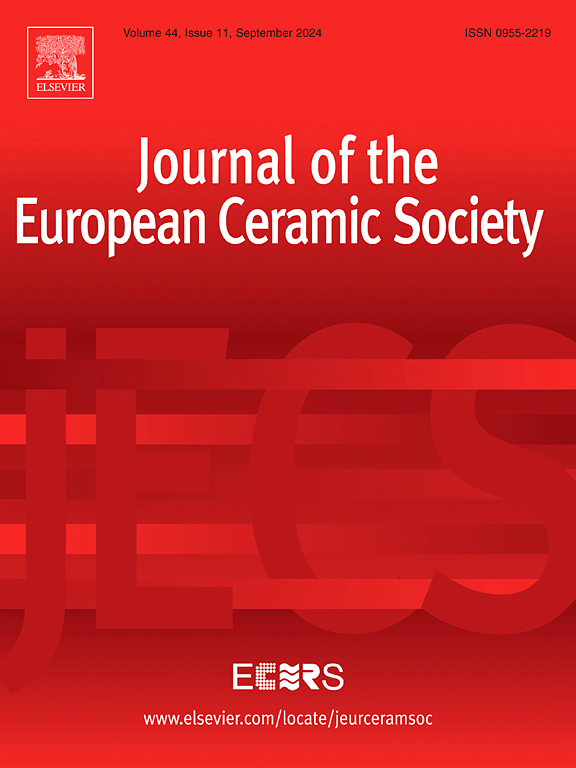Enhanced oxidation/ablation resistance of (Hf0.5Zr0.5)C over HfC-ZrC via high oxygen-atom storage capacity across temperatures
IF 5.8
2区 材料科学
Q1 MATERIALS SCIENCE, CERAMICS
Journal of The European Ceramic Society
Pub Date : 2025-06-14
DOI:10.1016/j.jeurceramsoc.2025.117625
引用次数: 0
Abstract
The essential reason for the oxidation/ablation behavior of multi-phase carbides and single-phase solid solution carbides with the same composition is obscure. Herein, the oxidation/ablation behaviors of HfC-ZrC multi-phase carbide (HZMC) and (Hf0.5Zr0.5)C single-phase solid solution carbide (HZSC) at different temperatures were studied. Experimental results confirmed a higher onset oxidation temperature of HZSC powders (640 °C) than HZMC powders (440 °C), and HZSC coating demonstrated superior ablation resistance (240 s) relative to HZMC coating (180 s). First-principle calculations by VASP displayed a higher O storage capacity in the HZSC lattice due to a lower average O-interstice energy of HZSC (-2.10 eV) than HZMC (44.52 eV). It avoided the rapid consumption of C atoms and subsequent HZSC lattice collapse during initial oxidation/ablation, followed by slowing down the average high-temperature O atom migration of HZSC (2.58 Å-6.83 Å, from 25 °C to 2180 °C) in comparison to HZMC (3.09 Å-7.66 Å). Therefore, performance data validation integrated with computational optimization revealed the enhanced O storage capacity of HZSC endowed it with superior oxidation/ablation resistance. These findings provided valuable insights into the expansion of the design space for high-temperature structural materials.
与HfC-ZrC相比,HfC-ZrC的(Hf0.5Zr0.5)C抗氧化/烧蚀能力增强
相同成分的多相碳化物和单相固溶体碳化物的氧化/烧蚀行为的根本原因尚不清楚。本文研究了HfC-ZrC多相碳化物(HZMC)和(Hf0.5Zr0.5)C单相固溶体碳化物(HZSC)在不同温度下的氧化/烧蚀行为。实验结果表明,HZSC粉末的起氧化温度(640℃)高于HZMC粉末(440℃),HZSC涂层的抗烧蚀性能(240 s)优于HZMC涂层(180 s)。VASP第一原理计算表明,由于HZSC的平均O间隙能(-2.10 eV)低于HZMC(44.52 eV), HZSC晶格中的O存储容量更高。它避免了在初始氧化/烧蚀过程中C原子的快速消耗和随后的HZSC晶格崩溃,随后与HZMC (3.09 Å-7.66 Å)相比,HZSC (2.58 Å-6.83 Å,从25°C到2180°C)的平均高温O原子迁移速度减慢。因此,结合计算优化的性能数据验证表明,HZSC增强的O存储容量使其具有优异的抗氧化/抗烧蚀性能。这些发现为扩展高温结构材料的设计空间提供了有价值的见解。
本文章由计算机程序翻译,如有差异,请以英文原文为准。
求助全文
约1分钟内获得全文
求助全文
来源期刊

Journal of The European Ceramic Society
工程技术-材料科学:硅酸盐
CiteScore
10.70
自引率
12.30%
发文量
863
审稿时长
35 days
期刊介绍:
The Journal of the European Ceramic Society publishes the results of original research and reviews relating to ceramic materials. Papers of either an experimental or theoretical character will be welcomed on a fully international basis. The emphasis is on novel generic science concerning the relationships between processing, microstructure and properties of polycrystalline ceramics consolidated at high temperature. Papers may relate to any of the conventional categories of ceramic: structural, functional, traditional or composite. The central objective is to sustain a high standard of research quality by means of appropriate reviewing procedures.
 求助内容:
求助内容: 应助结果提醒方式:
应助结果提醒方式:


